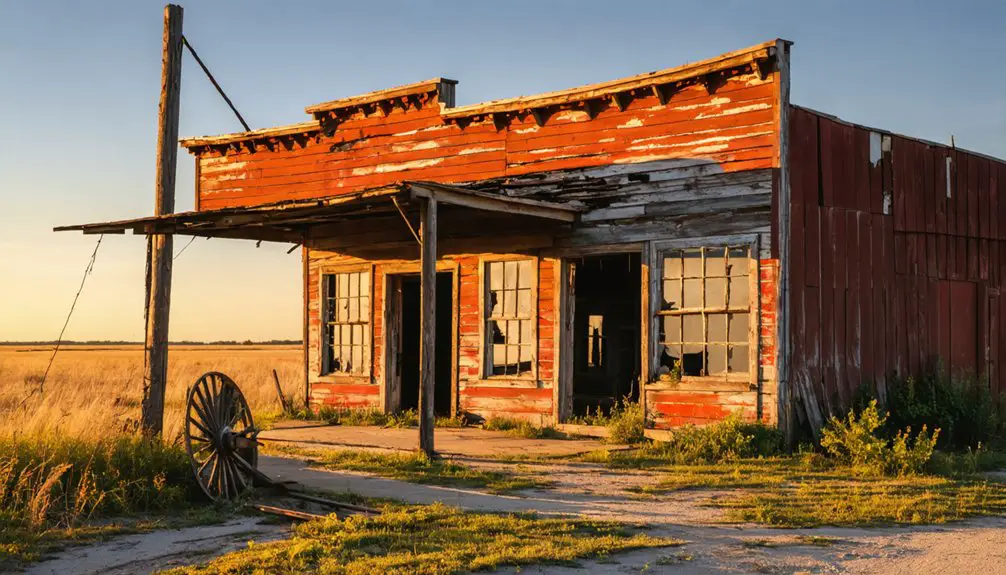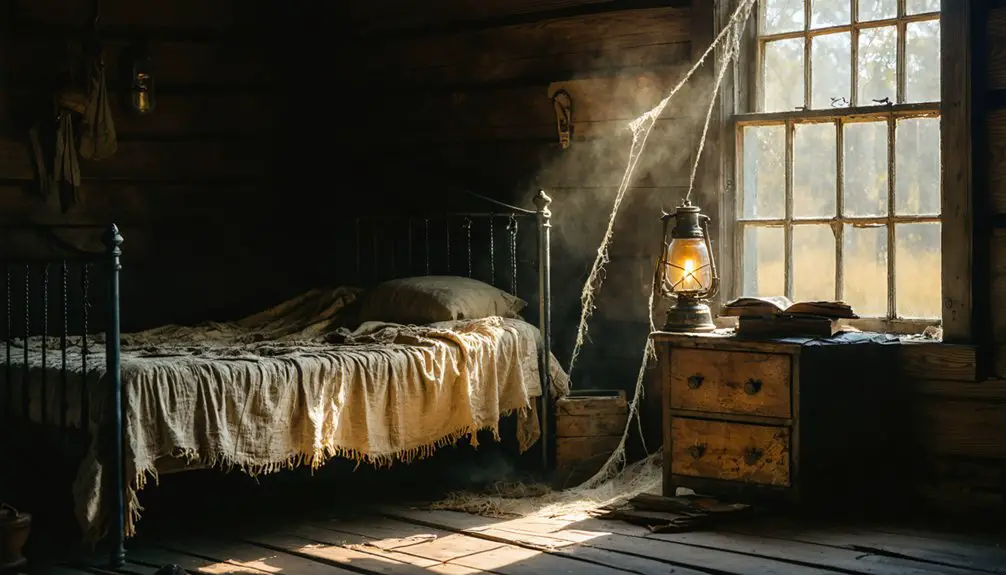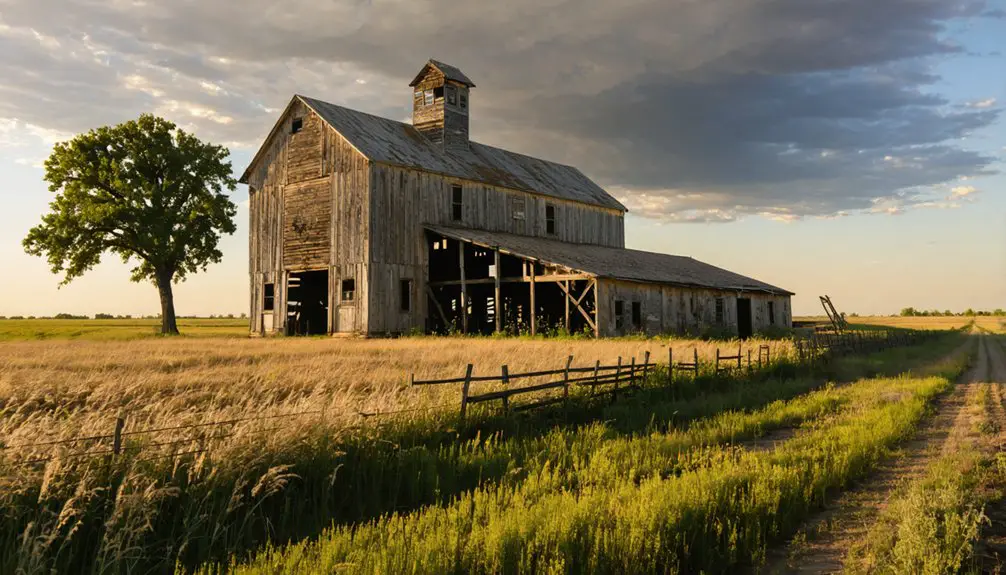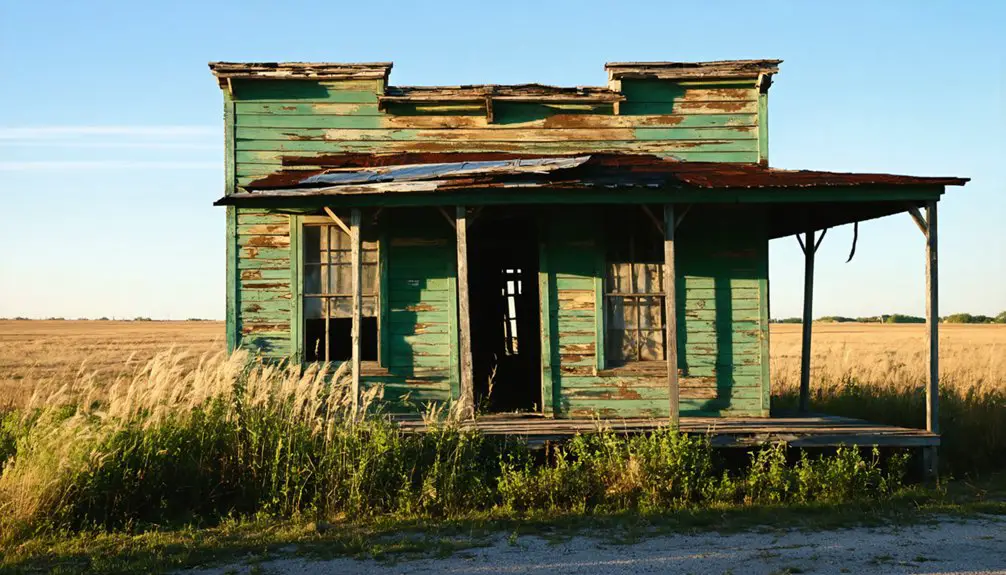You’ll find Medora’s ghost town remnants in Reno County, Kansas, where a once-bustling frontier settlement met its fate after a dramatic 1904 relocation. The town moved a mile southwest to follow the Rock Island Railroad’s new depot, but this couldn’t prevent its eventual decline. Today, Becker’s Bunkhouse, a former hotel-turned-museum, stands as the last original structure from 1907, holding countless stories of Kansas’ pioneer and ranching heritage within its walls.
Key Takeaways
- Medora was a Kansas frontier settlement that peaked at 200 residents in the late 1800s before declining into a ghost town.
- The entire town relocated one mile southwest in 1904-1905 to follow the Rock Island Railroad’s new depot location.
- Railroad bypasses and changing transportation routes isolated Medora from vital trade networks, leading to economic decline.
- Mechanized farming and the Great Depression drove younger residents to cities, leaving businesses closed and buildings abandoned.
- A former hotel built in 1907 serves as the last original structure, now functioning as a living museum of pioneer artifacts.
Origins and Early Settlement
As the Oregon Trail brought settlers and traders through Reno County, Kansas in the late 19th century, the small town of Medora emerged as a promising frontier settlement.
You’ll find its roots deeply connected to the arrival of the railroad in the 1880s, which spurred settler motivations to establish a community around limestone quarrying and agricultural practices. Similar to other Kansas towns like Bigelow, the area became known for its limestone quarrying operations.
Just as towns like Empire City, the community experienced rapid growth in its early days, attracting residents with economic opportunities.
The town’s post office opened in 1887, serving a growing population that would reach about 200 residents at its peak.
What’s particularly interesting is Medora’s physical relocation around 1904-1905, when the entire town moved about a mile southwest of its original site.
The early settlers balanced quarry work with farming ventures, including possible catalpa and apple tree cultivation in the surrounding fertile lands.
The Great Relocation of 1904
If you’d lived in Medora during 1904, you’d have witnessed an extraordinary feat as the entire community uprooted and moved southwest to follow the Rock Island Railroad’s new depot location.
Building by building, residents and business owners either physically transported their structures or rebuilt them at the new site, coordinating their efforts to maintain the town’s essential services throughout the shift.
The one-room schoolhouse proved especially important to community cohesion, continuing to operate through the move and serving as an anchor for the relocated population.
This move coincided with broader changes in Reno County as the area saw population top 30,000 residents.
Today, the relocated brick schoolhouse from old Medora stands vacant after being moved again in 2011.
Townsite Moving Logistics
During the pivotal year of 1904, Medora, Kansas undertook a remarkable logistical challenge when the entire townsite relocated approximately one mile to the southwest.
You’ll find this massive undertaking required extensive community involvement, with local residents and business owners working together to overcome significant logistical challenges.
The relocation process demanded careful coordination of:
- Transportation of buildings using horse teams and early machinery
- Adaptation of existing structures for movement across the plains
- Strategic timing to minimize disruption to the general store and school operations
- Management of resources and manpower from the community
This ambitious move transformed the town’s landscape, requiring residents to navigate complex terrain while preserving essential community assets. Similar to how von Gunten’s carpentry shop helped with millwork manufacturing during this era, local craftsmen were essential to the structural modifications needed for building transport.
Though documentation remains limited, the relocation stands as an example of the determination and resourcefulness of early Kansas settlers. The town would later become a stop along the Valley Center-Medora railway line, connecting it to the broader regional transportation network.
Community Response Challenges
The 1904 relocation of Medora brought unprecedented challenges to its tight-knit community, testing the social fabric that had bound neighbors together for years.
You’d have witnessed families struggling with emotional distress as they left behind familiar streets and landmarks, while watching their social networks strain under the pressure of displacement. Local merchants faced tough choices, shouldering substantial costs to reestablish their businesses near the Rock Island depot.
Despite initial resistance, community nostalgia eventually gave way to emotional resilience as residents adapted to their new surroundings. Some families chose to stay behind, creating a demographic shift that temporarily disrupted local governance and voting structures. The area would later become part of the Valley Center to Medora rail line segment.
Essential services like the post office and schoolhouse faced interruptions, but the community’s determination ultimately preserved their town’s core institutions.
Life in Old Medora

Life in old Medora revolved around its central gathering spots – the LaPorte family’s general store, one-room brick schoolhouse, and bustling post office.
These hubs fostered rural traditions and community bonding in this Kansas prairie town, where resourceful children scavenged pop bottles from ditches to trade for strawberry and orange sodas at what later became Becker’s Bunkhouse. Like many Kansas towns that faced economic depressions, Medora saw its population steadily decline over the decades. To avoid confusion with other places named Medora, locals often referred to it as Kansas Medora.
Your daily life in old Medora would’ve included:
- Working the limestone quarries that connected to railroad commerce
- Farming the fertile Kansas soil as technology evolved
- Gathering for social events at the schoolhouse that served as a community anchor
- Walking to the post office, which served residents continuously from 1878 to 1988
The town’s proximity to the Oregon Trail linked you to the broader story of American westward expansion.
Decline of a Prairie Town
While Medora’s community spirit once thrived around its general store and schoolhouse, sweeping changes in agriculture and transportation gradually unraveled the town’s fabric.
The heartbeat of Medora’s close-knit community faded as modernization slowly dismantled its cherished gathering places and rural foundations.
You’d have witnessed the impact of mechanization as larger farms required fewer workers, leading to a steady economic decline. The town’s physical move southwest in the early 1900s couldn’t halt the exodus of families seeking opportunities elsewhere. Like many towns affected by bad weather and minerals, the community struggled to maintain its population base.
The Great Depression and Dust Bowl dealt harsh blows to Medora’s community resilience. As younger generations left for bigger cities, essential services disappeared – the school closed, businesses shuttered, and streets emptied.
The loss of reliable railroad connections further isolated the settlement. What was once a bustling prairie town succumbed to the broader forces reshaping rural Kansas, leaving behind vacant buildings and quiet streets as evidence to changing times.
Becker’s Bunkhouse: A Living Museum

Standing as a tribute to Medora’s railroad heritage, Becker’s Bunkhouse preserves a slice of early 20th-century Kansas within its weathered walls.
As the last original structure from Medora Junction built in 1907, this former hotel-turned-living museum now houses Steven Becker’s extensive collection of pioneer and cowboy artifacts.
You’ll discover what makes this historic gem unique through:
- Original architecture that served as both a hotel and general store
- Authentic antiques and memorabilia highlighting Kansas’ ranching legacy
- Personal tours by Becker, a former judge who’s dedicated to preservation
- Direct connections to the region’s railroad history and settlement
Visit on Fridays and Saturdays when Becker’s around, or reach out directly to arrange a tour of this intimate slice of prairie history.
Transportation’s Role in Medora’s Fate
You’ll find that Medora’s eventual decline began when the railroad bypassed the town in favor of other regional routes, shifting commerce and transportation patterns away from the once-bustling settlement.
As automobile travel gained prominence, new highways were constructed that also avoided Medora, further isolating the community from essential trade networks.
The early dirt roads that once connected Medora to neighboring towns gradually lost their significance, leaving the settlement increasingly cut off from the region’s economic lifelines.
Railroad Bypass Impact
As the Atchison, Topeka & Santa Fe Railroad carved its routes through Kansas in the late 19th century, Medora found itself increasingly isolated from the region’s crucial transportation arteries.
Railroad decisions favored routes to key resource points like Carbondale’s coal deposits, bypassing smaller settlements in favor of freight logistics.
While you’d find Medora on the Chicago and Rock Island line, its absence from major rail junctions proved devastating to the town’s future.
The railroad bypass impact crippled Medora’s economy in four critical ways:
- Reduced freight shipping opportunities compared to intersection towns
- Loss of crucial railroad-related jobs and commerce
- Declining ability to sustain essential businesses like general stores
- Limited access to emerging economic opportunities that railroad junctions provided
Highway Routes Shift Away
When highway planners reconfigured major routes through Kansas in the mid-20th century, Medora’s fate mirrored its earlier railroad troubles.
You’ll find that major highway realignments prioritized larger towns and cities, leaving Medora isolated from essential transportation corridors. Highway 166 and other routes shifted closer to Arkansas City, dramatically altering regional traffic patterns.
The changes devastated Medora’s local businesses that relied on passing travelers. Gas stations, diners, and motels saw their customer base vanish as vehicles bypassed the town entirely.
Without political influence to attract highway projects, Medora couldn’t compete with larger communities that absorbed the economic benefits of new routes. The town’s economy narrowed to agriculture, while infrastructure and community services declined due to reduced municipal revenues and dwindling population.
Early Roads Lost Importance
The roots of Medora’s transportation woes stretched back well before the highway changes, beginning with the decline of its original lifelines.
You’d have witnessed the gradual erosion of road usage as newer transportation methods emerged, leaving Medora’s early routes increasingly irrelevant.
The transportation decline manifested in four critical ways:
- Wagon trails and early roads that once brought essential commerce became less traveled.
- Mail and supply routes redirected away from the settlement.
- Alternative corridors emerged, drawing traffic from traditional paths.
- Railroad development bypassed the town entirely.
Without maintaining its position as a transit point, Medora couldn’t sustain its economic vitality.
The shift from horse-drawn transport to mechanized travel meant established routes lost their significance, and the town’s isolation deepened as surrounding communities gained superior connections.
Agricultural Changes and Population Shifts
Dramatic shifts in agricultural technology transformed Medora’s destiny throughout the 20th century.
You’ll find that agricultural innovation brought mechanized farming, hybrid seeds, and expansive irrigation systems that enabled fewer farmers to work larger tracts of land. While this boosted productivity, it also triggered widespread rural unemployment as farms consolidated and required less labor.
The ripple effects devastated Medora’s social fabric.
You’d have seen younger residents moving to cities for work, while the elderly remained behind. As the population dwindled, local businesses couldn’t survive – grocery stores closed, professionals relocated, and community institutions faltered.
The town’s remaining infrastructure deteriorated as farming evolved from diverse crops to primarily grain production and cattle ranching, mirroring the fate of many Kansas farming communities that couldn’t sustain themselves in an increasingly mechanized agricultural economy.
Historical Significance Today

Despite its physical disappearance, Medora stands as a compelling case study of early Kansas settlement patterns and rural decline.
You’ll find its cultural legacy preserved mainly through historical documentation and collective memory, while its educational impact lives on through the story of its brick schoolhouse.
Today, Medora’s historical significance is reflected in:
- Photographic collections and postcards that capture the original townsite’s appearance
- The preserved records of its one-room schoolhouse, which exemplify rural education in early 1900s Kansas
- Its role as a Missouri Pacific Railroad stop, highlighting the importance of rail transportation in early Kansas development
- The documented pattern of community relocation and eventual ghost town status, which mirrors many similar Kansas settlements
Frequently Asked Questions
Are There Any Documented Paranormal Activities or Ghost Stories in Medora?
You won’t find documented ghost sightings or officially recorded local legends in Medora – it’s surprisingly quiet on the paranormal front compared to Kansas’s more active haunted ghost towns.
What Happened to the Original Buildings From the First Medora Site?
You won’t find architectural remnants from the first site – most buildings were demolished or relocated when the town moved southwest in 1904-1905. No historic preservation efforts saved structures from the original location.
How Many People Currently Live Within Medora’s Original Town Boundaries?
You won’t find official current population counts within Medora’s original town boundaries, though historical significance suggests minimal to zero permanent residents there today, with most people living in the broader township instead.
Can Visitors Explore the Original Townsite Location on Their Own?
You can’t freely explore the original townsite since it’s on private property. Like most Kansas ghost towns, you’ll need landowner permission first to access any remaining structures or ruins.
Were There Any Notable Crimes or Outlaws Associated With Medora?
You won’t find outlaw legends here – the crime history mainly involves settler disputes like Sumner Smith’s suspicious death and Bill Landis’s shooting of Mr. Fry, rather than notorious criminals.
References
- https://jpankratz15.wixsite.com/portfolio/post/becker-s-bunkhouse-a-hidden-kansas-gem
- https://www.youtube.com/watch?v=OyBXD18P_j4
- https://legendsofkansas.com/kansas-ghost-town-list/
- https://en.wikipedia.org/wiki/List_of_ghost_towns_in_Kansas
- http://kansasghosttowns.blogspot.com/2012/03/medora-kansas-reno-county-town.html
- https://www.youtube.com/watch?v=iB5rHT14eVI
- https://www.youtube.com/watch?v=alC1wDdSVvg
- http://kansasghosttowns.blogspot.com/2013/03/a-listing-of-reno-county-dead-towns.html
- https://accessgenealogy.com/wp-content/uploads/2024/09/Hutchinson-a-prairie-city-in-Kansas.pdf
- https://ia601307.us.archive.org/22/items/standardhistoryo00conn/standardhistoryo00conn.pdf



